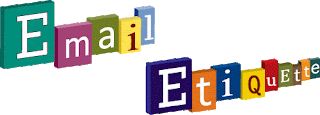Hello Viewers,
Email Etiquette
But despite the fact that were glued to our reply buttons, career coach Barbara Pachter says plenty of professionals still dont know how to use email appropriately.
In fact, because of the sheer volume of messages were reading and writing each day, we may be more prone to making embarrassing errors and those mistakes can have serious professional consequences.
Pachter outlined the basics of modern email etiquette in her book The Essentials Of Business Etiquette. We pulled out the most essential rules you need to know.
Use a clear, direct subject line
Examples of a good subject line include Meeting date changed, Quick question about your presentation, or Suggestions for the proposal.
People often decide whether to open an email based on the subject line, Pachter says. Choose one that lets readers know you are addressing their concerns or business issues.
Use a professional email address
If you work for a company, you should use your company email address. But if you use a personal email account whether you are self-employed or just like using it occasionally for work-related correspondences you should be careful when choosing that address, Pachter says.
You should always have an email address that conveys your name so that the recipient knows exactly who is sending the email. Never use email addresses (perhaps remnants of your grade-school days) that are not appropriate for use in the workplace, such as babygirl@... or beerlover@... no matter how much you love a cold brew.
Think twice before hitting reply all
No one wants to read emails from 20 people that have nothing to do with them. Ignoring the emails can be difficult, with many people getting notifications of new messages on their smartphones or distracting pop-up messages on their computer screens. Refrain from hitting reply all unless you really think everyone on the list needs to receive the email, Pachter says.
Include a signature block
Provide your reader with some information about you, Pachter suggests. Generally, this would state your full name, title, the company name, and your contact information, including a phone number. You also can add a little publicity for yourself, but dont go overboard with any sayings or artwork.
Use the same font, type size, and color as the rest of the email, she says.
Use exclamation points sparingly
If you choose to use an exclamation point, use only one to convey excitement, Pachter says.
People sometimes get carried away and put a number of exclamation points at the end of their sentences. The result can appear too emotional or immature, she writes. Exclamation points should be used sparingly in writing.
Be cautious with humor
Humor can easily get lost in translation without the right tone or facial expressions. In a professional exchange, its better to leave humor out of emails unless you know the recipient well. Also, something that you think is funny might not be funny to someone else.
Pachter says: Something perceived as funny when spoken may come across very differently when written. When in doubt, leave it out.
Proofread every message.
Your mistakes wont go unnoticed by the recipients of your email. And, depending upon the recipient, you may be judged for making them, Pachter says.
Dont rely on spell-checkers. Read and re-read your email a few times, preferably aloud, before sending it off.
One supervisor intended to write Sorry for the inconvenience, Pachter says. But he relied on his spell-check and ended up writing Sorry for the incontinence.
Double-check that youve selected the correct recipient
Pachter says to pay careful attention when typing a name from your address book on the emails To line. Its easy to select the wrong name, which can be embarrassing to you and to the person who receives the email by mistake.
Keep your fonts classic
Purple Comic Sans has a time and a place (maybe?), but for business correspondence, keep your fonts, colors, and sizes classic. The cardinal rule: Your emails should be easy for other people to read. Generally, it is best to use 10- or 12- point type and an easy-to-read font such as Arial, Calibri, or Times New Roman, Pachter advises. As for color, black is the safest choice.

